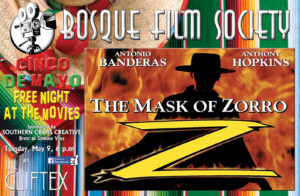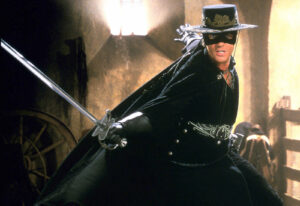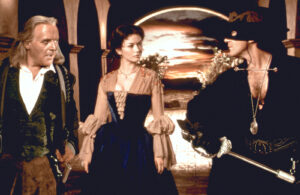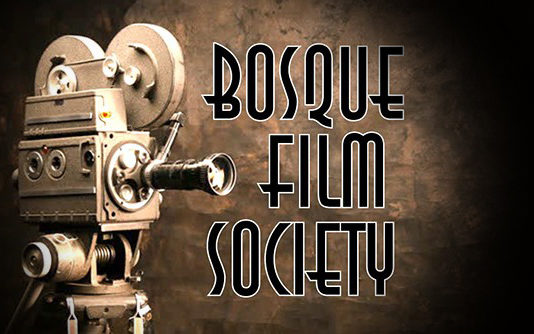Masked Man Rides Again: Based on Mexican folktales, “The Mask of Zorro” celebrates Cinco de Mayo at The Cliftex Theatre as the Bosque Film Society presents Free Night At The Movies May 9
By SIMONE WICHERS-VOSS
Bosque Film Society Founding Board Member
The Anniversary of the Battle of Puebla is celebrated in parts of Mexico and the United States marking the historical significance of a symbolically important military victory in 1862 over the French forces of Napoleon III. Much better known as Cinco de Mayo, it is a day of food, drink, parades and dancing, and has become a day of celebration of Hispanic heritage and culture.
 To honor the heritage and culture of the many Hispanic residents – nearly 19 percent of the population in Bosque County – the Bosque Film Society and the historic Cliftex Theater will celebrate Cinco de Mayo on Tuesday, May 9 at 6 p.m. Under the motto “when the world need a folk hero, he rides again,” they offer a free showing of Martin Campbell’s highly entertaining 1998 “The Mask of Zorro” starring Sir Anthony Hopkins, Antonio Banderas and Catherine Zeta-Jones.
To honor the heritage and culture of the many Hispanic residents – nearly 19 percent of the population in Bosque County – the Bosque Film Society and the historic Cliftex Theater will celebrate Cinco de Mayo on Tuesday, May 9 at 6 p.m. Under the motto “when the world need a folk hero, he rides again,” they offer a free showing of Martin Campbell’s highly entertaining 1998 “The Mask of Zorro” starring Sir Anthony Hopkins, Antonio Banderas and Catherine Zeta-Jones.
The movie will be introduced by Clifton High School Spanish teacher Fatima Carthart and her students prior to show time at 6 p.m. Admission will be free to the public on a first-come, first serve basis, and the usual Cliftex concessions will be available for purchase.
Campbell is the director of the James Bond movie “Goldeneye.” While nominated for several prestigious awards, it did not win any. That did not prevent the movie from being a commercial success. The movie is described as “from start to finish, never a dull moment,” “splendid swashbuckling entertainment with great choreographed sword fights,” and “Crisp and competent and often witty.”
“It’s a reminder of the time when stunts and special effects were integrated into stories, rather than the other way around,” renowned film critic Roger Ebert said, admiring the traditional film craftsmanship.”
 When Alejandro enters the training circle, he makes a swirling circular move with his sword – the signature move of Errol Flynn. Not really surprising, since legendary sword trainer Bob Anderson, who trained Errol Flynn, also trained Banderas for this movie. Anderson remarked that Banderas was the most gifted swordsman with whom he had worked since Flynn. Banderas had also trained with the Spanish Olympic team for four months.
When Alejandro enters the training circle, he makes a swirling circular move with his sword – the signature move of Errol Flynn. Not really surprising, since legendary sword trainer Bob Anderson, who trained Errol Flynn, also trained Banderas for this movie. Anderson remarked that Banderas was the most gifted swordsman with whom he had worked since Flynn. Banderas had also trained with the Spanish Olympic team for four months.
The original Zorro, the mysterious black-caped masked avenger of the oppressed, Don Diego de la Vega played by Hopkins is captured and imprisoned just as Spain concedes California to Mexico in 1821. Twenty years later, Zorro returns from exile to avenge the death of his wife, who was killed by his mortal enemy, Don Rafael Montero – played by Stuart Wilson. The aging Zorro trains a young bandit Alejandro Murrieta played by Banderas to be his successor. To complicate the situation, Zeta Jones is Zorro’s beautiful daughter, who was raised by Montero.
While “The Mask of Zorro” and its sequel “The Legend of Zorro” are fictional, the stories do incorporate certain historical events and people into their narrative. Banderas’ character, Alejandro Murrieta, is a fictional brother of Joaquin Murrieta, a Mexican outlaw who was killed in 1853 by the California State Rangers led by Harry Love – portrayed in the film as Texas Army Captain “Harrison Love.”
The character of Don Diego de la Vega is a Criollo Mexican, a full blooded Spaniard born in New Spain during the days of the viceroyalty. The Criollos were part of the ruling elite in New Spain/Spanish America just under the Peninsulares –Spanish-born governing authorities.
There is a distinct difference between the costumes for Don Diego de la Vega’s Zorro and Alejandro Murrieta’s Zorro. Costume designer Graciela Mazón claimed that de la Vega’s costume portrayed his Spanish heritage, while Alejandro’s portrayed his Mexican heritage.
American pulp fiction writer Johnston McCulley created the first Zorro story, which was published in the April 1959 issue of the pulp magazine “Short Stories For Men.” The compelling action story has been translated to film across the globe over 40 times, including the 1940 “The Mark of Zorro,” with Douglas Fairbanks and the 1940 classic starring Tyrone Power and Basil Rathbone. But Ebert gave the 1998 film “probably the best Zorro movie ever made.”
 In the stories, Zorro has a high bounty on his head, but is too skilled and cunning for the bumbling authorities to catch, and he also delights in publicly humiliating them. Because of this, the townspeople started calling him “El Zorro” due to his foxlike cunning and charm. Zorro is an acrobat and an expert in various weapons, but the one he employs most frequently is his rapier, which he uses often to carve the initial “Z” on his defeated foes, and other objects to “sign his work”. He is also an accomplished rider, with a trusty steed, a black horse called Tornado.
In the stories, Zorro has a high bounty on his head, but is too skilled and cunning for the bumbling authorities to catch, and he also delights in publicly humiliating them. Because of this, the townspeople started calling him “El Zorro” due to his foxlike cunning and charm. Zorro is an acrobat and an expert in various weapons, but the one he employs most frequently is his rapier, which he uses often to carve the initial “Z” on his defeated foes, and other objects to “sign his work”. He is also an accomplished rider, with a trusty steed, a black horse called Tornado.
The character also inspired in ten TV series, including the famous Disney-produced Zorro series of 1957–59, starring Guy Williams. Zorro also appears in several stories written by other authors, comics books and strips, stage productions, video games and other media.
Being one of the earliest examples of a fictional masked avenger with a double identity, Zorro inspired the creation of several similar characters in pulp magazines and other media, and is a precursor of the superheroes of American comic books, with Batman drawing particularly close parallels to the character.
Spoiler alert: At the end of the movie, Murrieta whispers to his baby son “And so it was. Lighting split the sky, thunder shook the earth, and then all was quiet. The great warrior known as Zorro was gone. The people of the land gave him a hero’s funeral, the largest anyone had ever seen. They came from far and wide to say farewell to their brave and noble champion.
But don’t worry, little Joaquin. Whenever great deeds are remembered, your grandfather will live on. For there must always, always be a Zorro. And some day, when he’s needed, we will see him again… on his fearsome steed Tornado, riding like the wind, his sword blazing in the sun… leaping, jumping, swinging through the air… fighting like a lion. Fighting like a tiger.”
With this film, the Bosque Film Society celebrates Hispanic heritage.
Photos & videos courtesy of SONY PICTURES
©2023 Southern Cross Creative, LLP. All rights reserved. This material may not be published, broadcast, rewritten, or redistributed.
